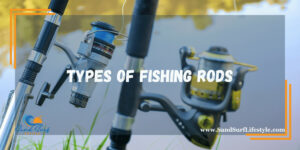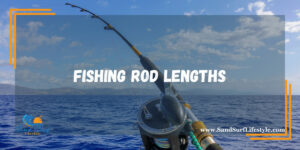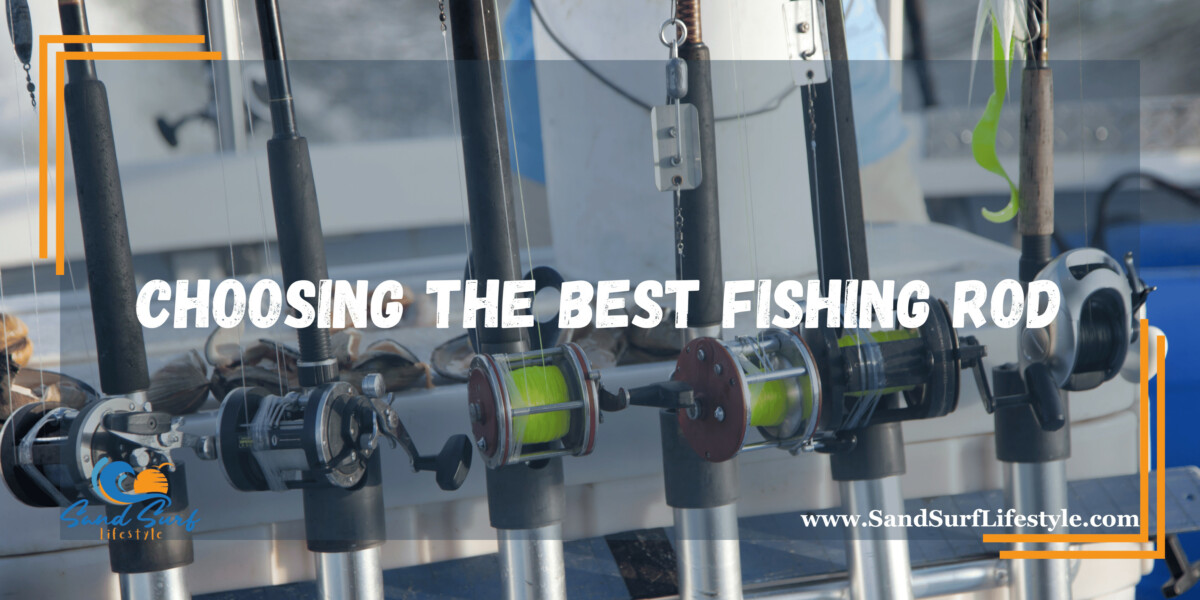Fishing, often described as a serene and meditative activity, has captivated the hearts of outdoor enthusiasts for centuries. One of the most critical components of a successful fishing experience is the fishing rod. Whether you’re a seasoned angler or a novice, selecting the right fishing rod can significantly impact your fishing performance.
Types of Fishing Rods

Fishing rods come in various types, each designed for specific fishing techniques and environments. Understanding these types is crucial when making your selection:
1. Spinning Rods
Spinning rods are incredibly versatile and the top choice for both novices and seasoned anglers. Their adaptability shines in various settings, including freshwater and light saltwater fishing. These rods are expertly paired with spinning reels, and their hallmark is their user-friendly nature and remarkable flexibility. The ease of casting and control they offer makes them an ideal starting point for beginners, while their adaptability continues to impress experienced anglers, allowing them to pursue a wide array of fish species and fishing styles with confidence.
2. Baitcasting Rods
Baitcasting rods cater to the experienced angler’s demand for precision. They truly shine when it comes to pinpoint casting, making them the preferred choice in heavy cover or when targeting larger, more elusive fish. Baitcasting reels are securely mounted atop these rods, offering exceptional accuracy and control during casting. This combination empowers anglers to land their bait or lures exactly where they intend, making baitcasting rods the go-to choice for those who relish the challenge of precision casting.
3. Fly Fishing Rods
Fly fishing rods are meticulously crafted for the art of fly fishing, a distinct angling technique centered around casting lightweight artificial flies. These rods come in a spectrum of lengths and weights, meticulously matched to the nuances of specific fly lines and the unique conditions of fly fishing. Each aspect of a fly fishing rod is designed to harmonize with the subtle motions and delicate presentations required in this method. They are a reflection of an angler’s finesse, making them indispensable for those enchanted by the elegance and precision of fly fishing.
4. Trolling Rods
Trolling rods are the unsung heroes of anglers who employ trolling, a technique that involves slowly dragging lines with bait or lures behind a moving boat. These rods are built to withstand the rigors of this method, featuring robust construction, and are often equipped with sturdy guides. Trolling reels are specially designed to complement these rods, ensuring the smooth deployment and retrieval of lines while maintaining precise control over the baits or lures. Trolling rods are trusted companions for those seeking to explore deeper waters and trawl for larger game fish.
5. Ice Fishing Rods
When winter’s icy grip takes hold, anglers turn to ice fishing rods, purposefully designed for the unique challenges of frozen lakes and rivers. These rods are notably shorter in length, offering better maneuverability in cramped ice shanties and limited space. Their primary focus is on sensitivity, enabling anglers to detect even the subtlest nibbles from fish beneath the ice. Built with materials that can withstand frigid conditions, ice fishing rods are essential tools for those who brave the cold to indulge in the serene and rewarding world of ice fishing.
To learn about the best aluminum boats for saltwater fishing, check out this article.
Fishing Rod Materials
The material from which a fishing rod is constructed plays a significant role in its performance and durability. Common materials used in rod construction include:
1. Fiberglass
Fiberglass fishing rods are renowned for their remarkable durability and budget-friendly price tags. While they may not match the sensitivity levels of some other materials, their robust construction allows them to handle heavy loads and withstand the wear and tear of angling adventures. Fiberglass rods are particularly favored by beginners for their forgiving nature, making them an ideal choice for those just embarking on their angling journey. Their resilience and affordability combine to create a trustworthy companion, ensuring that even novice anglers can confidently pursue their fishing passions without breaking the bank.
2. Graphite/Carbon Fiber
Graphite or carbon fiber fishing rods are the darlings of experienced anglers, celebrated for their featherlight construction and exceptional sensitivity. These rods excel in transmitting every subtle nuance of the underwater world, providing anglers with precise feedback that aids in detecting even the most delicate nibbles. This heightened sensitivity is especially prized when targeting elusive or finicky fish species. Graphite rods are renowned for their ability to deliver pinpoint accuracy during casting, making them the preferred choice for anglers who demand top-tier performance and a deep connection with their quarry.
3. Composite
Composite fishing rods represent a harmonious blend of materials, often combining the durability of fiberglass with the sensitivity of graphite or carbon fiber. This marriage of materials results in a versatile rod that strikes an optimal balance between strength and responsiveness. Composite rods are engineered to cater to a broad spectrum of angling scenarios, making them suitable for those who seek an all-around performer. With the ability to handle varying conditions and fish sizes, these rods are the go-to choice for anglers who refuse to compromise on either durability or sensitivity.
4. Bamboo
For those who harbor a deep appreciation for tradition and nostalgia, bamboo fishing rods hold a unique allure. While they are less prevalent in today’s angling landscape, bamboo rods possess a classic charm and storied history, particularly in the world of fly fishing. The natural feel and craftsmanship of bamboo rods are cherished by traditionalists who value the connection to angling’s roots. Though less common, bamboo rods continue to evoke the spirit of a bygone era, making them treasured pieces in the arsenal of anglers who embrace the timeless elegance of this material.
Fishing Rod Actions
The action of a fishing rod refers to its flexibility or stiffness, specifically how much the rod bends under pressure. The primary rod actions include:
1. Fast Action
Fast-action fishing rods are characterized by their pronounced bending primarily in the upper part of the rod, near the tip. This distinctive flex pattern makes them outstanding tools for specific angling scenarios. Their primary strength lies in their ability to propel lures or bait to impressive distances during casting. Anglers seeking to cover more water or entice surface-feeding fish, such as those targeted in topwater fishing, favor these rods. Moreover, their rapid responsiveness is indispensable when quick hook sets are essential, ensuring a higher hookup ratio and adding excitement to the angling experience.
2. Medium Action
Medium-action fishing rods gracefully bend along the midsection of the rod, striking a harmonious balance between casting distance and sensitivity. This versatility makes them the preferred choice for many anglers, as they can adapt to a wide range of fishing styles and environments. Whether casting for bass in freshwater or targeting inshore species in saltwater, medium-action rods prove to be reliable companions. Their ability to transmit subtle vibrations from bait or lures is a key advantage, helping anglers detect strikes while maintaining the power needed to handle a variety of fish sizes.
3. Slow Action
Slow-action fishing rods bend along their entire length, showcasing their exceptional sensitivity. This unique flex profile allows anglers to feel even the faintest nibble or hesitant bite. Slow-action rods are particularly well-suited for situations demanding finesse, such as using light lines or presenting small lures to wary fish. Anglers who appreciate the delicate art of angling find these rods indispensable when pursuing species that require a gentle touch. Whether you’re casting in a serene trout stream or angling for panfish, slow-action rods offer a heightened connection to the underwater world and a more immersive angling experience.
Fishing Rod Lengths

The length of your fishing rod affects your casting distance, control, and the type of fishing you can do. Here are some common length considerations:
1. Short Rods (4-6 feet)
Short fishing rods, typically measuring between 4 to 6 feet in length, serve as versatile tools tailored for specific angling scenarios. Their compact size makes them invaluable in confined spaces, such as densely vegetated areas or narrow streams where overhanging branches and obstacles pose casting challenges. Short rods offer anglers exceptional control and precision, allowing for pinpoint accuracy when placing bait or lures. However, it’s important to note that their limited length sacrifices casting distance, making them best suited for close-quarters fishing, where maneuverability and control take precedence over distance.
2. Medium Rods (6-7.5 feet)
Medium-length fishing rods, ranging from 6 to 7.5 feet, are renowned for their adaptability and versatility across a wide spectrum of fishing scenarios. These rods strike a harmonious balance, offering both control and the ability to achieve respectable casting distances. Whether you’re casting from the shore of a tranquil lake, wading in a river, or fishing from a boat, medium rods prove to be reliable companions. Their adaptability extends to various fishing styles and environments, making them a go-to choice for anglers seeking a well-rounded tool that can handle diverse angling challenges.
3. Long Rods (8 feet and above)
Long fishing rods, typically measuring 8 feet or more, are the favored choice when casting extraordinary distances is paramount. These rods excel in scenarios like surf fishing from the shoreline or when attempting to reach fish in distant pockets of water from a stationary position. Their elongated design allows for impressive casting power, propelling bait or lures far from the angler’s location. While they offer unparalleled casting capabilities, it’s important to acknowledge that the trade-off for this distance is some loss of control, particularly in close-quarters situations. Long rods are essential tools for those seeking to conquer extensive waters and reach elusive fish.
Choosing the Right Fishing Rod
Selecting the perfect fishing rod involves considering several factors:
1. Fishing Style
Selecting the right fishing rod begins with understanding your preferred fishing style. Different techniques, whether it’s freshwater angling, saltwater adventures, the art of fly fishing, or the unique challenge of ice fishing, demand specialized rods. Each style has its unique requirements in terms of materials, actions, and lengths to maximize your success and enjoyment. Tailoring your rod choice to your chosen fishing style ensures you have the right tool for the job, enhancing your overall angling experience.
2. Target Species
The choice of your fishing rod should always consider the size and species of fish you aim to catch. Different fish have varying levels of strength and behavior, necessitating specific rod attributes. Whether you’re pursuing largemouth bass, mighty marlins, elusive trout, or delicate panfish, the appropriate rod strength, action, and sensitivity become crucial. Matching your rod to your target species increases your chances of landing that prized catch.
3. Fishing Environment
The environment where you plan to fish greatly influences your choice of fishing rod. Open water, dense vegetation, or ice-covered lakes each present distinct challenges. For example, fishing in confined spaces with overhanging branches might call for a shorter rod with precise control, while open-water fishing might require a longer rod for casting greater distances. The environment also dictates the type of fish you’ll encounter, affecting your rod’s action and length requirements.
4. Personal Preference
Acknowledging personal preference is vital when selecting a fishing rod. Your comfort and experience level significantly impact your choice. Some anglers may have a preference for the feel of certain materials like fiberglass or the responsiveness of graphite. Likewise, experienced anglers often gravitate toward specific rod actions that align with their casting style and finesse. Tailoring your rod choice to your personal preferences ensures you have a tool that feels natural and enhances your confidence on the water.
5. Budget
Determining your budget is a practical consideration in choosing a fishing rod. While high-end rods offer exceptional performance and craftsmanship, there are excellent options available for various budgets. Understanding the range of rods within your budget helps you make a well-informed decision, ensuring you get the most value for your investment. Regardless of your budget, it’s possible to find a rod that suits your needs and provides an enjoyable and rewarding fishing experience.
Maintenance and Care
Once you’ve invested in the perfect fishing rod, it’s essential to take proper care of it to ensure longevity and optimal performance:
1. Cleaning
Properly maintaining your fishing rod is essential to ensure its longevity and optimal performance. After each fishing excursion, it’s crucial to rinse your rod thoroughly with fresh water. This step helps remove any accumulated salt, sand, or debris, which can corrode the rod’s components over time. Once cleaned, allow the rod to air dry completely before storing it. This routine maintenance ensures that your rod remains in top condition and is ready for your next angling adventure.
2. Storage
When it comes to storing your fishing rods, a few precautions can go a long way in preserving their integrity. Store your rods in a cool, dry place away from direct sunlight and extreme temperatures. Exposure to prolonged sunlight or extreme heat can cause the rod’s materials to deteriorate. To provide an extra layer of protection, consider using rod holders or rod sleeves, which shield your rods from potential damage during storage. These measures help prolong the life of your fishing gear, ensuring it remains in excellent working condition.
3. Reel Maintenance
To maintain the smooth operation of your fishing reel, regular upkeep is essential. Follow the manufacturer’s instructions for cleaning and lubricating the reel. Typically, this involves disassembling the reel, cleaning its components, and applying lubricant to the moving parts. Properly maintained reels function more efficiently and extend the life of the fishing line by reducing friction. Routine reel maintenance is an investment in your angling experience, ensuring that your equipment operates flawlessly when you’re on the water.
4. Rod Guides
Paying attention to the condition of your rod guides is paramount. Periodically inspect the guides for any signs of wear or damage. Damaged guides, such as cracked or bent inserts, can adversely affect casting and line performance. In addition to visual inspection, run a cotton swab or a piece of pantyhose through each guide to check for any rough spots or snags that may damage your fishing line. Address any issues promptly by replacing or repairing damaged guides to maintain the smooth passage of the line, ensuring your casting accuracy and overall fishing success.
To learn about surf fishing tips for beginners, check out this article.
Conclusion
In the world of fishing, your choice of a fishing rod can be the difference between a successful outing and a frustrating one. Understanding the types, materials, actions, and lengths of fishing rods is crucial for making an informed decision. Whether you’re casting for bass in a serene lake or fly fishing for trout in a rushing river, the right fishing rod can make your experience more enjoyable and fruitful. So, consider your fishing style, target species, environment, and personal preferences when choosing the perfect fishing rod, and don’t forget to maintain it properly to ensure years of angling pleasure. Happy fishing!
Please note that the contents of this blog are for informational and entertainment purposes only and should not be construed as legal advice. Any action taken based on the information provided in this blog is solely at your own risk. Additionally, all images used in this blog are generated under the CC0 license of Creative Commons, which means they are free to use for any purpose without attribution.

